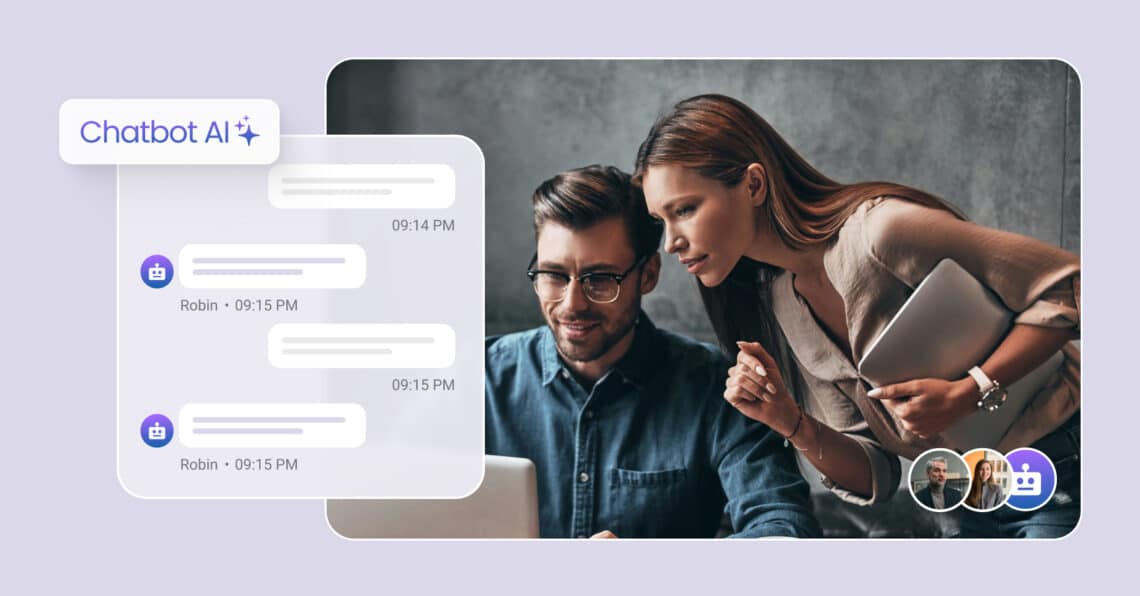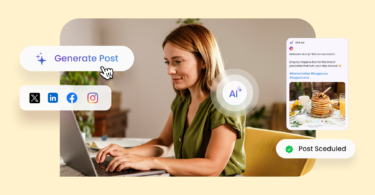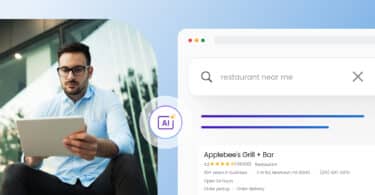In an era where customers expect instant responses and personalized service, traditional marketing strategies can’t keep up with the demand for real-time engagement. Businesses are now turning to a solution that’s fast, efficient, and available 24/7: chatbot marketing.
Whether shopping online at midnight or looking for instant product support, chances are you’ve interacted with a conversational marketing chatbot. But these virtual assistants do more than just answer FAQs. They can nurture leads, personalize customer journeys, boost conversions, and even reduce costs when used strategically.
In this blog, we’ll explore chatbot marketing, why it’s become a must-have in modern digital strategies, and how your business can implement it effectively to boost engagement and drive results.
Table of contents
- Key benefits of Chatbot marketing
- Chatbots vs. Conventional AI
- 7 steps to create a robust Chatbot marketing strategy
- Common chatbot pitfalls (and how to avoid them)
- Chatbot marketing example: How Birdeye’s AI chatbot helped Genesis Counseling Center
- Elevate your marketing with a chatbot: The takeaway
- Frequently asked questions on chatbot marketing strategy
- How Birdeye Chatbot AI boosts your marketing efforts
Before you dive in: What is a chatbot?
A chatbot is a software application designed to simulate human conversation through text or voice interactions. It can answer questions, provide support, or perform tasks by following predefined rules or using AI.
What is Chatbot marketing?
Chatbot marketing is a digital strategy where businesses use automated conversational interfaces, commonly called chatbots, to engage with customers and support marketing efforts. These bots simulate human conversation and are typically deployed on websites, messaging platforms like Facebook Messenger or WhatsApp, and even inside mobile apps.
Types of chatbots
- Rule-based bots, which follow pre-defined scripts to guide conversations.
- AI-powered bots, which use natural language processing (NLP) to understand and respond to complex queries.
These marketing chatbots can handle tasks like:
- Answering customer inquiries in real-time
- Offering personalized product recommendations
- Guiding users through sales funnels
- Scheduling appointments or demos
- Collecting contact information or qualifying leads
Here’s how chatbot marketing works in practice:
- A visitor lands on your website and is greeted by a chatbot.
- The bot asks a few targeted questions, learns about the visitor’s needs, and suggests relevant content or products.
- If the visitor is ready to buy, the chatbot can assist with checkout or schedule a call with a sales rep.
- All customer interactions are tracked, allowing for segmentation and retargeting later.
Chatbots help brands scale their marketing efforts while delivering a consistent, personalized experience across channels.
Key benefits of Chatbot marketing
Adopting chatbot marketing offers a wide range of benefits that extend beyond basic customer support. Here’s how chatbot for marketing technology drives value across the customer journey:
1. Enhanced customer engagement and brand loyalty
- Personalized interactions
Chatbots can analyze user data, such as past behavior, purchase history, and browsing habits, to deliver highly personalized content and responses. For example, a returning customer shopping for athletic shoes might be shown a curated list of new arrivals similar to their last purchase. This tailored experience increases engagement and makes customers feel valued, boosting brand and customer loyalty.
- 24/7 availability
Unlike human agents, chatbots never sleep, offering round-the-clock support regardless of time zones or business hours. Whether it’s a late-night question about product specs or a weekend request for order status, customers get instant help. This always-on availability enhances customer trust and creates a seamless experience across different touchpoints.
2. Increased sales and lead generation
- Instant responses and guided selling
Chatbots eliminate wait times by providing real-time answers to questions that would otherwise require human intervention. They can guide users through product discovery, compare features, address concerns, and even share promotional offers. For instance, an e-commerce chatbot might help a user find a perfect laptop by asking about budget, specs, and use-case needs.
- Lead qualification and nurturing
Chatbots can screen and segment leads by asking relevant questions like company size, industry, and budget range. This saves your sales team time by focusing only on high-quality leads who meet specific criteria. In a SaaS context, for example, a chatbot might ask users about their team size and preferred features before scheduling a demo.
3. Cost-effectiveness and scalability
- Reduced operational costs
Chatbots can handle hundreds or even thousands of conversations simultaneously, significantly lowering user interaction costs. They reduce the need for large customer support teams, especially for handling repetitive inquiries like tracking orders or resetting passwords. This frees human agents to focus on more complex tasks and provides a cost-efficient way to scale support.
- Highly scalable during peak periods
Chatbots can manage surges during high-traffic events like product launches, flash sales, or the holiday season without breaking down. Unlike human teams, they don’t require extra shifts or onboarding, making them a flexible solution for seasonal spikes. This ensures customers receive fast, reliable service when demand is at its highest.
4. Enhanced customer service and experience
- Faster query resolution
Chatbots deliver quick, consistent answers to common questions, eliminating the need for users to search through long FAQs. For instance, a telecom company might use a bot to walk users through troubleshooting a dropped connection step by step. This immediate support helps reduce frustration, keeps users on-site, and improves overall satisfaction.
- Consistent brand messaging
Since chatbots use scripted and approved content, they ensure every interaction aligns with the brand’s tone, values, and policies. This reduces the risk of miscommunication and helps establish a professional, trustworthy image. Whether it’s product details, return policies, or onboarding instructions, users always receive the right information.
5. Smarter data collection and insights
- Real-time customer data capture
Each chatbot interaction provides actionable data, such as questions asked, pages visited, and preferences shared. This data helps marketers understand customer needs and refine messaging, targeting, and content strategies accordingly. Over time, this results in more effective campaigns and better product development insights.
- Privacy-conscious analytics (No cookies required)
With growing privacy regulations and the decline of third-party cookies, chatbots offer a compliant way to collect first-party data. They can gather insights based on declared interests and behavior within the conversation itself. This creates a transparent, opt-in data model that respects user privacy while supporting personalized marketing.
Chatbots vs. Conventional AI
As businesses increasingly rely on automation to enhance customer interactions, understanding the difference between traditional chatbots and advanced conversational AI is essential. While both aim to streamline communication, they differ significantly in scope, intelligence, and adaptability.
Key differences
Scope of functionality
- Chatbots: Built for specific, predefined tasks such as answering FAQs or guiding users through simple workflows.
- Conversational AI: Handles various tasks and can manage fluid, multi-turn conversations with users.
Technology and intelligence
- Chatbots: Operate using fixed rules or decision trees, often lacking deep natural language understanding.
- Conversational AI: Leverages AI and machine learning to interpret language more like a human, understanding intent and context.
Flexibility and adaptability
- Chatbots: Limited in handling unexpected inputs; their responses are static and don’t improve over time.
- Conversational AI: Learns from each interaction, continuously enhancing its responses and adapting to user behavior.
Development and use
- Chatbots: Quicker and easier to develop; ideal for straightforward, single-purpose applications.
- Conversational AI: More complex to build but delivers richer, more scalable experiences across various use cases.
User experience
- Chatbots: Best suited for routine queries with predictable inputs.
- Conversational AI: Offers natural, human-like interaction, making it ideal for engaging and personalized experiences.
While chatbots serve as valuable tools for basic automation, they are increasingly seen as limited in today’s fast-evolving digital landscape. A conversational marketing chatbot, on the other hand, can deliver highly tailored experiences that mimic human interaction, especially valuable in complex sales or support environments.
7 steps to create a robust Chatbot marketing strategy
A well-planned chatbot marketing strategy enables brands to drive customer engagement, automate support, and increase conversions through intelligent, conversational experiences.
Here’s how to build a high-performing chatbot marketing strategy:
1. Set clear marketing goals for your chatbot
- Lead generation
Use your chatbot to offer value like discount codes or downloadable resources, in exchange for user contact info. This helps grow your email list and qualify leads early in the user journey with little friction. For example, a style quiz could collect emails while recommending curated fashion items.
- Customer support
Automate responses to common questions to offer fast, round-the-clock assistance without human involvement. This lowers operational costs and boosts satisfaction, especially during high-traffic hours or off-peak times. Add escalation options to hand complex issues to live agents when needed.
- Sales and conversions
Guide users through purchasing by answering product questions, suggesting items, and overcoming objections in real time. This can reduce bounce rates and increase sales, especially in industries with many product choices. For instance, a chatbot could recommend a laptop based on the user’s needs and budget.
- Brand awareness
Introduce your brand’s personality, story, or mission in an interactive and engaging format. Chatbots can help new visitors understand what makes your brand unique right from the first touchpoint. Use welcome flows or mini-stories to humanize the brand experience.
- Interactive campaigns
Use fun quizzes, product matchmakers, or mini-games to drive user engagement and collect zero-party data. These experiences not only entertain but also offer insights into user needs and preferences. A skincare brand, for example, might run a “find your skin type” quiz that ends with tailored product tips.
2. Know your audience and personalize the chatbot experience
- Target audience
Understand your users’ demographics, behaviors, and goals to design relevant chatbot conversations. The better your understanding, the more value your chatbot can deliver in real time. Use this insight to shape tone, language, and content.
- Customer segmentation
Segment users based on actions, preferences, or purchase history to deliver tailored messages and flows. Dynamic segmentation makes your chatbot smarter and more aligned with each user’s journey. For instance, repeat buyers could see exclusive offers that are not shown to new users.
3. Choose the right platforms for chatbot deployment
- Website integration
Place chatbots on high-intent pages like product or checkout to assist users at critical moments. They can answer FAQs, offer real-time product advice, or prompt lead capture forms. This improves site performance and reduces cart abandonment.
- Messaging apps
Use platforms like WhatsApp, Messenger, or Telegram to engage users where they already spend time. These channels are ideal for notifications, personalized offers, and high open rates. They also support multimedia elements like product videos and quick replies.
- Mobile app integration
Embed chatbots in your mobile app to support onboarding, share feature tips, or answer user questions. This boosts app retention and improves the in-app experience through guided journeys. Chatbots can also collect customer feedback or recommend upgrades.
4. Build thoughtful and user-friendly conversation flows
- Greeting and introduction
Start every chatbot interaction with a warm, engaging message that sets the tone and offers value upfront. Use personalized greetings if data is available, like “Hi John! Need help finding the right shoes today?” Clear CTAs help users know what they can ask or expect.
- Question and answer flow
Structure your chatbot with decision-tree logic that responds dynamically to user inputs. Using concise, natural language guides users smoothly to the right destination, like products, support, or lead capture. Buttons and quick replies help reduce typing and confusion.
- Personalized interactions
Adjust responses based on browsing history, previous purchases, or user preferences. This makes conversations more relevant and builds stronger relationships with your audience. For instance, greet returning users with “Welcome back! Ready to restock your supplements?”
- Data capture
To avoid form fatigue, ask for user details gradually and conversationally—like name, email, or preferences. Use this data to tailor future customer interactions and marketing touchpoints. Be transparent about why you’re collecting data and how it improves the experience.
Chatbot Marketing: Strategies, Benefits, and Challenges
Want to see the impact of Birdeye on your business? Watch the Free Demo Now.
5. Integrate your chatbot with core marketing tools
- CRM integration
Sync chatbot conversations with your CRM to automatically store leads, track user behavior, and trigger workflows. This keeps your sales and marketing teams aligned and enables more personalized follow-up. Use tags or scoring to prioritize high-value contacts.
- Analytics tools
Track chatbot metrics like engagement rate, drop-off points, and conversion to measure success. These insights help identify what’s working and where users are getting stuck. Use data to refine scripts, flows, and CTAs over time.
- Marketing automation
Connect your chatbot to tools like email or SMS platforms to trigger follow-ups based on user behavior. For example, email a product recommendation after a chatbot interaction about that product category. This extends chatbot value across your entire marketing ecosystem.
6. Test, measure, and continuously improve chatbot performance
- A/B testing
Experiment with different greetings, question structures, and CTAs to learn what drives better engagement. Track which variants lead to higher conversions or longer interactions. Regular testing helps keep your chatbot fresh and user-centric.
- User feedback
Ask users to rate their chatbot experience at the end of each conversation using emojis or short polls. Use this user feedback to spot friction points, confusing paths, or opportunities to expand functionality. Even negative feedback is a valuable roadmap for improvement.
- Content and flow updates
To maintain relevance, keep your chatbot updated with new products, seasonal offers, or FAQs. Outdated bots can harm credibility and user trust, so review scripts regularly. Plan monthly or quarterly updates based on business changes or campaign cycles.
7. Promote your chatbot across multiple channels
- Website prompts
Use banners, sliders, or popups to tell visitors what the chatbot can help with and invite engagement. Timed prompts—like on scroll or exit intent—can dramatically increase chatbot usage. Position them strategically on high-traffic or conversion-critical pages.
- Social media ads
Drive traffic to your chatbot via social media ads like Messenger or WhatsApp ads with lead magnets, special offers, or product finders. Ensure the ad CTA and chatbot flow are consistent for a smooth experience. These campaigns work well for list-building and retargeting.
- Email marketing
Embed chatbot links or callouts in your newsletters or post-purchase emails to offer quick help or product discovery. Phrases like “Chat with us to get your perfect skincare routine” can drive clicks. This bridges the gap between email and real-time engagement.
Common chatbot pitfalls (and how to avoid them)
While chatbot marketing offers powerful advantages, it’s not without its challenges. Many businesses dive in without a solid strategy, only to find their bots frustrating users instead of helping them. Here are some of the most common pitfalls and how to avoid them:
1. Over-automation without human fallback
Chatbots are great at handling routine queries, but they’re not a replacement for human empathy, especially when conversations get complex or emotional. Failing to offer a live agent option can leave users stuck and dissatisfied.
How to avoid it:
Build escalation paths into your chatbot flow. Offer a “Talk to a human” option early on, and ensure seamless handoff to support agents when needed.
2. Poor training and limited understanding
A chatbot that constantly replies “I didn’t understand that” will frustrate users quickly. This often happens when bots aren’t trained on enough real-world scenarios or lack natural language processing (NLP) capabilities.
How to avoid it:
Choose AI-powered bots with NLP, and invest time training them with actual customer conversations. Regularly review transcripts to improve understanding and expand their knowledge base.
3. One-size-fits-all messaging apps
Chatbots that deliver generic responses miss the opportunity to engage users meaningfully. If every visitor gets the same script, it can feel impersonal and off-brand.
How to avoid it:
Use behavioral and contextual data, such as pages visited, purchase history, or user segments, to tailor chatbot messages. Personalization increases relevance and drives better results.
4. Ignoring multilingual users
If your audience includes non-English speakers, an English-only chatbot can be a roadblock rather than a resource. You risk alienating a segment of your market.
How to avoid it:
Deploy multilingual chatbots or integrate translation tools to support key languages. At the very least, offer a language selection option at the start of the conversation.
Chatbots can be game-changing when used wisely. By sidestepping these common missteps and focusing on user experience, personalization, and thoughtful integration, you’ll avoid frustrating your audience and build stronger, more scalable customer relationships. Remember: a chatbot should enhance your brand, not hinder it.
Chatbot marketing example: How Birdeye’s AI chatbot helped Genesis Counseling Center
A powerful illustration of chatbot marketing that transformed patient engagement comes from Genesis Counseling Center, a mental health provider serving nearly 10,000 clients monthly across Virginia and Texas. Like many in healthcare, Genesis faced a growing demand for instant, empathetic communication—especially during patients’ most vulnerable moments.
The challenge
- Traditional communication (e.g., phone calls) limited Genesis’s ability to connect with new clients quickly.
- A poor online reputation (just 50 reviews with a 2.3-star rating) hurt credibility.
- Missed inquiries due to limited office hours and communication bottlenecks.
The solution
Genesis implemented Birdeye’s Chatbot AI to engage visitors 24/7 with real-time, human-like conversations. The chatbot:
- Instantly answered FAQs about services, insurance, and scheduling.
- Handled 100+ chats daily, with seamless handoffs to SMS if a visitor dropped mid-chat.
- Reduced reliance on phone calls and ensured no inquiry went unanswered.
They also used Messaging AI to:
- Consolidate all incoming messages into a single inbox.
- Summarize conversations for faster staff review.
- Rephrase responses with AI to ensure empathy and brand consistency.
The results
- Online rating soared from 2.3 to 4.6 stars, backed by over 1,400 new reviews.
- 100+ daily chats ensured always-on engagement.
- HIPAA-compliant messaging replaced outdated, insecure channels.
- Staff efficiency improved while patient trust and satisfaction grew.
“The AI Chatbot helps us jump-start connections. Patients feel supported, and our staff can work more efficiently.”A
— Steven Greer, COO, Genesis Counseling Center
Elevate your marketing with a chatbot: The takeaway
Chatbot marketing isn’t just for eCommerce; it’s transforming industries like healthcare by meeting people where they are, at any time. With AI tools like Birdeye, businesses can scale empathy, efficiency, and engagement all at once.
Frequently asked questions on chatbot marketing strategy
Chatbots provide instant, personalized responses 24/7, keeping users engaged and supported at every stage of their journey.
Yes—chatbots help reduce friction and drive faster buying decisions by guiding users through product choices and checkout.
Not at all. They also qualify leads, recommend products, promote campaigns, and collect zero-party data for smarter marketing.
Most modern chatbot platforms (like Birdeye) offer no-code builders, making it easy for marketers to create and manage chatbot flows without coding.
How Birdeye Chatbot AI boosts your marketing efforts
If you’re serious about turning website visitors into leads and potential customers, Birdeye’s Chatbot AI is your ultimate marketing ally. More than just a virtual assistant, it’s a powerful, intelligent tool that helps businesses engage, convert, and grow effortlessly.
What makes Birdeye chatbot AI different?
Always-on engagement
Deliver 24/7 personalized conversations that feel human, whether a visitor is browsing at 2 PM or 2 AM. Instantly answer questions, recommend products, all through one friendly interface.
Smarter conversations with AI
Birdeye Chatbot understands context and tone, ensuring each interaction is helpful, natural, and on-brand. It pulls from your top-performing content and FAQs to provide fast, accurate responses.
Seamless live agent handoff
When human support is needed, easily route chats to the right team member without losing context. Every chat starts with artificial intelligence but ends exactly where it should.
Capture and convert more leads
Forget clunky forms. Birdeye’s chatbot captures contact info in smooth, conversational flows and continues conversations via text if users drop off mid-chat.
Scale your team without adding headcount
Handle hundreds of conversations simultaneously, qualify leads, and route inquiries automatically while freeing up your live agents for high-priority cases.
Built for marketers, not developers
Launch fast with a no-code setup. Train your bot using existing SEO content or FAQs. Customize your widget to match your brand and start driving results today.
With 200,000+ businesses already seeing success, Birdeye isn’t just keeping up with the future of chatbot marketing—it’s shaping it.

Originally published









